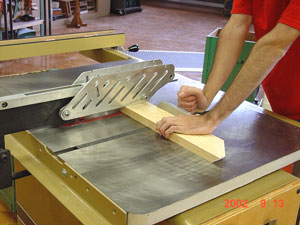Crosscutting on the Circular Saw
|
|
The circular saw is one of the most versatile machines used for woodworking. It can be used for a wide variety of operations including: ripping, crosscutting; as well as other operations such as cutting miters, rabbets, dados, and coves. This sheet describes the procedure for crosscutting stock to length. |
Controls: The controls on the circular saw in the materials processing laboratory consist of the following:
- A magnetic power switch that must be reset if the power in the laboratory is interrupted.
- A blade height adjustment wheel on the front of the machine.
- A blade tilt adjustment wheel on the side of the machine.
- Fence adjusting knob and fence lock on the rip fence.
Note: There are other controls on various accessories used with the saw that are not listed in this discussion.
Potential hazards: Because of the rapid spinning motion of the circular saw blade, the following hazards exist.
- Any body contact with the moving blade will cause severe injury.
- Clothing or other articles that contact the moving blade could become entangled and pull the operator into the blade.
- The work piece can be thrown (kicked back) violently from the rotating saw blade.
- Small pieces of the work piece and saw dust can be thrown out at the operator.
- The operator could slip and fall into the saw.
Safety practices: Because of those potential hazards the following safety rules must be followed.
- Be sure to perform only operations you know how to do safely.
- Always wear safety glasses.
- Never wear cloths or other articles that dangle and could catch on the saw.
- Be sure to have firm footing.
- Check the saw to make sure it is in good working order.
- Make all adjustments with the saw turned off, and unplugged in cases where the blade is or could be touched.
- Use an appropriate saw blade guard when possible. (most operations can be done with the guard), check with the instructor before making any cuts without the guard.
- Adjust the blade to 1/8 inch above the top of the stock.
- Check the stock for foreign objects and never saw stock containing loose or unsound knots.
- Never make "free hand" cuts on the circular saw, always use the fence, miter gage or other fixture.
- Never stand directly behind the saw blade.
- When using the miter gage be sure it slides freely and clears the blade.
- Do not reach directly over the moving blade to remove stock.
- Use a push stick for narrow work when ripping.
- Turn the saw off before clearing any materials from near the blade.
- Always use a clearance block when cross cutting duplicate parts (do not use the fence and miter gage in direct combination), the stock can bind and kick back .
- Have someone help support long stock, but don't allow them to pull the stock.
- Avoid distractions, never look away during a cut.
- Do not allow others to crowd around the saw.
- Turn the saw off immediately if it does not sound right or if slivers of wood catch between the blade and table.
- Always push the work well beyond the blade when finishing a cut (clearing the saw).
- Never let go of the stock during the cut.
- Do not saw stock that rocks on the table or that does not track straight along the fence.
- Lower the blade below the table surface after after finishing the operation.
Operation (Crosscutting): Crosscutting is the operation during which the stock is pushed widthwise through the blade. Refer to the following illustrations.
- Be sure that the stock to be cut is flat and has a straight edge.
- Have someone help provide support for long stock.
- Check to be sure that a crosscut or combination blade is mounted on the saw.
- Adjust the saw blade to approximately 1/8 to 1/4 inch higher than the thickness of the stock.
- Always use the miter gage for all crosscutting with the circular saw.
- Never use the rip fence with this operation without using spacer blocks to assure that the stock does not contact the fence during the cut (see next step).
- Mark the length to be cut on the stock or clamp a
short piece of wood to the rip fence if making several
cuts that are to be the same width. The clamped piece of
wood should be far enough way from the blade so the stock
will not touch the blade and the clamped wood at the same
time. This will help to prevent kickback.
- Be sure the blade guard is in place and functioning properly.
- Stand to the side of the blade and start the saw. Be sure no other people are in line with the blade.
- Using the miter gage on the left side of the blade, push the stock through.
- Be sure to push the stock well clear of the blade when finishing the cut (clearing the saw).
- Turn off the saw before removing the stock
 |
|
Stock is being pushed into the blade using the miter gage, note the position of the hands and that the fence is not used. |
References:
Hammond, James J., Donnelly, Edward T., Harrod, Walter F., Rayner, Norman A. (1972). Woodworking Technology. McKnight and McKnight Publishing Co. Bloomington, IL.
Feirer, John L. (1988). Cabinetmaking and Millwork. Glencoe/McGraw-Hill. Peoria, IL.
ITT 252 - Materials Processing
Department of Technology
University of Southern Maine
Prepared by Kevin M. Hanscom, 9/6/2001